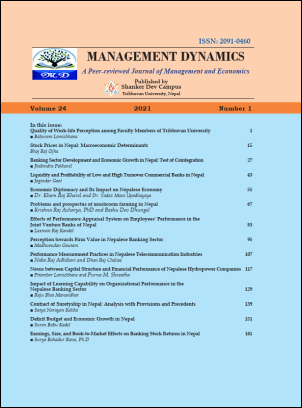Banking Sector Development and Economic Growth in Nepal: Test of Cointegration
DOI:
https://doi.org/10.3126/md.v24i1.47540Keywords:
banking sector, causality, cointegration, economic growth, VECMAbstract
This paper examined the causal relationship between banking sector development and economic growth in Nepal using annual time series data from 1975 to 2019. The per capita real GDP growth rate is taken as the proxy of economic growth. Private sector credit is used as the indicator of banking sector development and inflation, trade openness, and government spending as control variables. Using the Johansen cointegration test and vector error correction method (VECM) in regression analysis, the study reveals that the development of the banking sector in Nepal is positively contributing to economic growth through efficient allocation of financial resources. The findings from this study conclude that there is a unidirectional causality running from banking sector development to economic growth in the long run, which supports the supply-leading hypothesis. However, this study found no support for causality running from economic growth to banking sector development neither in the long run nor in the short run. Therefore, the findings from this study recommend policies that increase the reach of the banking services to small and medium enterprises (SMEs) and individual investors, even in the rural areas of the country.
Downloads
Downloads
Published
How to Cite
Issue
Section
License
Copyright © Research Management Cell, Shanker Dev Campus

